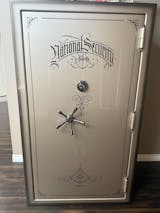What Do Gun Safe Ratings Mean?
There’s a lot of variety in the home and gun safe industry, from glorified gun cabinets to miniature fortresses. But what exactly do the gun safe ratings mean? Safe ratings serve as a baseline metric to help you choose a gun safe.
There are primarily two types of gun safe ratings: insurance ratings, and ratings for burglary-resistant safes that are based on performance testing.
Insurance Ratings
Insurance ratings are—shockingly, we know—issued by insurance agencies. These ratings are determined primarily by the construction of the safe rather than on any testing of the safe’s security. The ratings used by insurance agencies, from least to most secure, are:
- B
- C
- E
- ER
- F
- G&A
The B Insurance Classification
The “B” insurance classification indicates that a safe has a body less than ½” thick and a door less than 1” thick. This classification also indicates that the safe hasn’t been tested by Underwriters Laboratories. (More on Underwriters Laboratories below!)
The C Insurance Classification
The “C” insurance classification indicates a safe body of at least ½” thick and a door at least 1” thick. “C” safes haven’t been tested by Underwriters Laboratories.
The E Insurance Classification
The “E” insurance classification indicates safe walls of at least 1” thick and a door of at least 1 ½” thick. “E” is the final untested rating.
UL Ratings
From this point on, all gun safe ratings are determined based on testing done to ensure a safe can withstand common burglary attempts. These ratings are verified by Underwriters Laboratories, or UL. Underwriters Laboratories is a century-old organization that tests retail products. The UL team certifies for levels of safety, security, and reliability. They also verify claims made by manufacturers. They’re a trusted third-party, and their ratings are the gold standard for the safe industry and many others.
Residential Security Container Level 1
The first UL rating is Residential Security Container (RSC) level 1. To qualify, a safe must withstand five minutes of vigorous break-in attempts by a single person. These attempts come via a variety of methods, including prying, punching, drilling, tampering, and more. If a safe doesn’t come with at least this rating, it’s probably not a smart buy.
Residential Security Container Level 2
An RSC level 2 rating means a safe can withstand an attack by two people, using more tools, for 10 minutes. RSC level 3 refers to 3 people using even more tools for 10 minutes… you get the idea.
TL-15 Safe Ratings
TL ratings typically apply to commercial-grade safes rather than residential security containers. The U.L. rating TL-15 (the equivalent insurance rating is “ER”) indicates that a safe is constructed of at least 1” thick solid steel (or equivalent), and that it can withstand a full 15 minutes of break-in attempts. For a TL-15 rated safe, only the door or face of the safe is attacked. The 15 minutes is “net working time,” meaning that when the tool isn’t in contact with the safe, the clock is stopped.
To earn this rating, safes typically have a specialized design. The most common designs that meet this standard (and beyond) are concrete- or composite-lined safes. This means the safe has steel on the outside, then a thick layer of concrete or composite to make it more secure. As a result, these safes are far more expensive than RSC safes, and tend to weigh a lot.
TL-30 (F) Safe Ratings
The only difference between the TL-30 rating and the TL-15 rating is the net working time. TL-30’s are tested for break-in resistance for 30 minutes. The insurance rating equivalent is “F.”
TL-30x6 (G&A) Safe Ratings
Lastly, we have the TL-30-by-6. This rating is the same as the TL-30, except unlike the other categories, TL-30x6’s are tested on every side. That’s where the 30x6 comes in –break-in attempts are made on every surface, including the floor, for 30 minutes. Plus, these safes have to resist attempts from additional break-in methods, such as grinder and peeling attacks. As a result, they’re just about the most secure thing you can have outside of a bank vault.
There are additional TL ratings: TRTL-30 means the safe is attacked by tools or torches on the door or face for 30 minutes. TRTL 30x6 is attacked on all sides of the safe. TXTL 60x6 means all sides are attacked by tools, torches, AND explosives. Yep… explosives.
Download our PDF on Gun Safe Ratings Explained.









